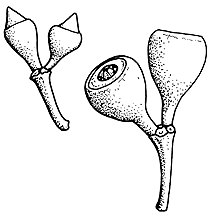Common name: Grey Ironbark
Eucalyptus paniculata Sm. APNI* 
Description: Tree to 30 m high; bark persistent throughout, grey-black, 'ironbark'.
Juvenile leaves disjunct, ovate, glossy green to dull green. Adult leaves disjunct, lanceolate to broad-lanceolate, 8–12 cm long, 1.2–3 cm wide, green, semi-glossy, discolorous.
Conflorescence compound; umbellasters 7-flowered; peduncle narrowly flattened or angular, 6–15 mm long; pedicels terete, 2–7 mm long. Buds ovoid or shortly fusiform, 7–9 mm long, 3–5 mm diam., scar present; calyptra conical, shorter and narrower than hypanthium. Outer stamens infertile; anthers cuboid.
Fruit hemispherical, conical or pyriform or ovoid, 4- or 5-locular, smooth or angular, 6–9 mm long, 5–8 mm diam.; disc depressed or flat; valves enclosed or rim-level. Locally frequent, in wet forest on deeper soils of higher fertility; coastal districts from Bulahdelah to Bermagui.
Distribution and occurrence:
NSW subdivisions: NC, CC, SC, CT, CWS
Text by K. Hill
Taxon concept:
| | Key to the subspecies | |
| 1 | Adult leaves with stomates confined to the lower surface except for a narrow band of scattered stomates along the midrib of the upper surface | subsp. paniculata |
| Adult leaves with some stomates on the upper surface, i.e. with a regular scattering of stomates over the upper surface, but at much lower densities than those on the lower surface. | subsp. matutina |
APNI* Provides a link to the Australian Plant Name Index (hosted by the Australian National Botanic Gardens) for comprehensive bibliographic data
***The AVH map option provides a detailed interactive Australia wide distribution map drawn from collections held by all major Australian herbaria participating in the Australian Virtual Herbarium project.
|


